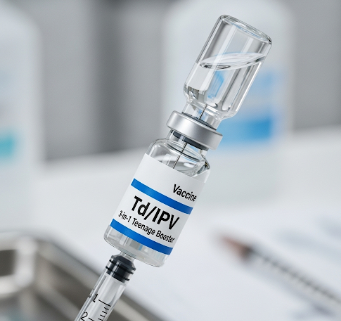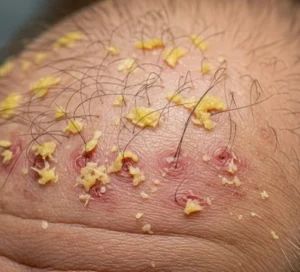What it is
The Td/IPV vaccine is a combined immunization that protects teenagers against three serious diseases:
➡ Components:
- Tetanus (T) → Bacterial infection causing severe muscle spasms and lockjaw
- Diphtheria (d) → Respiratory infection leading to throat obstruction, heart, and nerve damage
- Polio (IPV) → Viral infection causing paralysis
✔ Often called the 3-in-1 teenage booster, it is administered to children around 11–12 years old to maintain immunity acquired in early childhood.
✔ Uses inactivated poliovirus (IPV), making it safe and non-infectious.
✔ In Korea, the vaccine is widely available in pediatric clinics, hospitals, and public health centers.
💡 The Td/IPV booster strengthens immunity against diseases that can cause serious complications if not properly immunized.
Why it’s done
Vaccination with Td/IPV is recommended to:
➤ Boost waning immunity → Immunity from early childhood vaccinations may decrease over time
➤ Prevent life-threatening infections → Tetanus, diphtheria, and polio can cause severe illness or death
➤ Protect communities → Contributes to herd immunity and prevents disease outbreaks
➤ Meet school or public health requirements → Often required for school enrollment in Korea
⚠ Without booster vaccination, teenagers and adults may lose protection and become susceptible to these infections.
Alternatives / Complementary Measures
Although vaccination is the primary preventive measure:
✔ Previous immunization history → Early childhood vaccines help, but boosters are essential
✔ Hygiene and infection control → Good wound care and sanitation reduce tetanus risk
✔ Polio eradication programs → Safe water, hygiene, and outbreak control support vaccination efforts
⚠ No effective treatment exists for some complications of these diseases; vaccination is the safest preventive strategy.
Preparation
Before receiving the Td/IPV booster in Korea:
🔹 Medical history review → Check prior vaccinations and allergic reactions
🔹 Health assessment → Ensure the child is free of acute illness or fever
🔹 Allergy check → Ensure no history of severe allergic reactions to vaccine components
🔹 Consent → Parents or guardians provide informed consent for vaccination
💡 Clinics in Korea provide educational materials and counseling to ensure families understand the benefits, schedule, and side effects.
How it’s done
➡ Step-by-step administration:
- Location → Intramuscular injection, typically in the upper arm (deltoid muscle)
- Dosage → Single booster dose for teenagers
- Procedure → Quick injection, lasting only a few seconds
- Post-vaccination observation → 15–30 minutes to monitor for rare immediate reactions
💡 The procedure is quick, safe, and usually painless, with most children experiencing only mild discomfort at the injection site.
Effectiveness & Success Rate
✔ Highly effective → Provides strong immunity against tetanus, diphtheria, and polio
✔ Booster impact → Ensures continued protection into adolescence and adulthood
✔ Public health success → Korea has very low incidence of tetanus, diphtheria, and polio due to high vaccination coverage
💡 Maintaining booster schedules is critical for long-term immunity and preventing outbreaks.
Recovery / Expected Outcomes
✔ Mild side effects → Pain, redness, or swelling at the injection site
✔ Systemic reactions → Rare fever, fatigue, or mild headache
✔ Activity resumption → Normal activities can be resumed immediately
✔ Follow-up → Routine childhood immunization schedule continues; no additional doses required until adulthood
💡 Most teenagers experience minimal disruption and quickly develop protective antibodies.
Complications / Risks
⚠ Td/IPV vaccine is extremely safe, but possible risks include:
➡ Local reactions:
- Pain, redness, swelling at injection site
- Mild tenderness for 1–2 days
➡ Systemic reactions (rare):
- Fever
- Fatigue or headache
- Allergic reactions (very rare)
💡 Korean clinics have emergency protocols to handle any rare adverse events immediately.
Treatment Options in Korea (Post-Vaccination Care)
🔹 Symptom management: Pain relief with paracetamol or cold compress for injection site
🔹 Observation: Monitor for any unusual reactions within 24–48 hours
🔹 Medical consultation: Contact pediatrician if fever, rash, or severe discomfort occurs
🔹 Record keeping: Update vaccination records for school or travel requirements
💡 Korean public health centers maintain comprehensive immunization records to ensure proper follow-up and booster adherence.
Availability in Korea
🏥 Hospitals and pediatric clinics – Administer booster vaccines as part of routine adolescent care
🏥 Public health centers – Provide free or subsidized vaccination under national immunization programs
🏥 School vaccination programs – Facilitate booster administration for enrolled students
🏥 Travel clinics – Offer vaccination for teenagers traveling abroad
💡 Korea’s well-organized immunization programs ensure wide access to Td/IPV boosters nationwide.
Conclusion
The Td/IPV (3-in-1 teenage booster) vaccine in Korea is a safe, effective, and essential immunization to protect teenagers against tetanus, diphtheria, and polio.
✔ Boosts immunity from early childhood vaccinations
✔ Prevents severe disease, complications, and potential outbreaks
✔ Safe with minimal side effects and rare serious reactions
✔ Widely available through hospitals, clinics, public health centers, and school programs
By ensuring teenagers receive this booster, Korea maintains high vaccination coverage, protects public health, and safeguards the next generation from preventable diseases.













